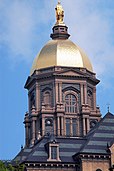Main Page: Difference between revisions
push the rest of the non-responsive changes |
Rm stray space in markup |
||
| Line 1: | Line 1: | ||
<templatestyles src="Wikipedia:Main Page/styles.css" |
<templatestyles src="Wikipedia:Main Page/styles.css"/> |
||
<div id="mp-topbanner" class="mp-bordered"> |
<div id="mp-topbanner" class="mp-bordered"> |
||
<div id="mp-welcomecount"> |
<div id="mp-welcomecount"> |
||
Revision as of 22:52, 21 June 2020
From today's featured articleHeptamegacanthus is a genus of acanthocephalans (thorny- or spiny-headed parasitic worms) containing a single species, Heptamegacanthus niekerki. This worm is a parasite of the endangered giant golden mole found only in isolated forests near East London and in the Transkei, both in South Africa. The worms are about 4 millimetres (0.2 in) long and 2 millimetres (0.08 in) wide with minimal sexual dimorphism. Their body consists of a short trunk and a proboscis with 40 to 45 hooks arranged in rings, which are used to pierce and hold the rectal wall of its host. The life cycle of H. niekerki remains unknown; however, like other acanthocephalans, it likely involves complex interactions with at least two hosts. Although the intermediate host for Heptamegacanthus is not definitively identified, it is presumed to be an arthropod, such as an insect, which is eaten by the giant golden mole. The worms then mature and reproduce sexually within the mole's lower gastrointestinal tract, creating eggs which are released in its feces. (Full article...)
Did you know ...
|
In the news
On this dayNovember 26: Feast day of Saint Sylvester Gozzolini (Catholicism); Constitution Day in India (1949)  Main Building of the University of Notre Dame
More anniversaries:
|
Today's featured picture

|
Ice eggs, also known as ice balls, are a rare phenomenon caused by a process in which small pieces of sea ice in open water are rolled over by wind and currents in freezing conditions and grow into spheroid pieces of ice. They sometimes collect into heaps of balls on beaches where they pack together in striking patterns. The gentle churn of water, blown by a suitably stiff breeze, makes concentric layers of ice form on a seed particle that then grows into the floating ball as it rolls through the freezing currents. This formation of ice eggs was photographed in 2014 on Stroomi Beach in Tallinn, Estonia. The temperature was around −20 to −15 °C (−4 to 5 °F), and the diameter of each ball around 5 to 10 centimetres (2 to 4 in). Photograph credit: Aleksandr Abrosimov
Recently featured:
|
Other areas of Wikipedia
- Community portal – The central hub for editors, with resources, links, tasks, and announcements.
- Village pump – Forum for discussions about Wikipedia itself, including policies and technical issues.
- Site news – Sources of news about Wikipedia and the broader Wikimedia movement.
- Teahouse – Ask basic questions about using or editing Wikipedia.
- Help desk – Ask questions about using or editing Wikipedia.
- Reference desk – Ask research questions about encyclopedic topics.
- Content portals – A unique way to navigate the encyclopedia.
Wikipedia's sister projects
Wikipedia is written by volunteer editors and hosted by the Wikimedia Foundation, a non-profit organization that also hosts a range of other volunteer projects:
-
Commons
Free media repository -
MediaWiki
Wiki software development -
Meta-Wiki
Wikimedia project coordination -
Wikibooks
Free textbooks and manuals -
Wikidata
Free knowledge base -
Wikinews
Free-content news -
Wikiquote
Collection of quotations -
Wikisource
Free-content library -
Wikispecies
Directory of species -
Wikiversity
Free learning tools -
Wikivoyage
Free travel guide -
Wiktionary
Dictionary and thesaurus
Wikipedia languages
This Wikipedia is written in English. Many other Wikipedias are available; some of the largest are listed below.
-
1,000,000+ articles
-
250,000+ articles
-
50,000+ articles


